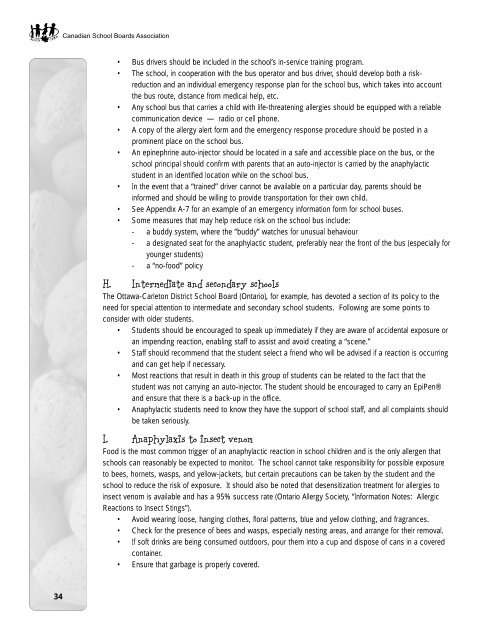Anaphylaxis - Canadian School Boards Association
Anaphylaxis - Canadian School Boards Association
Anaphylaxis - Canadian School Boards Association
You also want an ePaper? Increase the reach of your titles
YUMPU automatically turns print PDFs into web optimized ePapers that Google loves.
<strong>Canadian</strong> <strong>School</strong> <strong>Boards</strong> <strong>Association</strong>• Bus drivers should be included in the school’s in-service training program.• The school, in cooperation with the bus operator and bus driver, should develop both a riskreductionand an individual emergency response plan for the school bus, which takes into accountthe bus route, distance from medical help, etc.• Any school bus that carries a child with life-threatening allergies should be equipped with a reliablecommunication device — radio or cell phone.• A copy of the allergy alert form and the emergency response procedure should be posted in aprominent place on the school bus.• An epinephrine auto-injector should be located in a safe and accessible place on the bus, or theschool principal should confirm with parents that an auto-injector is carried by the anaphylacticstudent in an identified location while on the school bus.• In the event that a “trained” driver cannot be available on a particular day, parents should beinformed and should be willing to provide transportation for their own child.• See Appendix A-7 for an example of an emergency information form for school buses.• Some measures that may help reduce risk on the school bus include:- a buddy system, where the “buddy” watches for unusual behaviour- a designated seat for the anaphylactic student, preferably near the front of the bus (especially foryounger students)- a “no-food” policyH. Intermediate and secondary schoolsThe Ottawa-Carleton District <strong>School</strong> Board (Ontario), for example, has devoted a section of its policy to theneed for special attention to intermediate and secondary school students. Following are some points toconsider with older students.• Students should be encouraged to speak up immediately if they are aware of accidental exposure oran impending reaction, enabling staff to assist and avoid creating a “scene.”• Staff should recommend that the student select a friend who will be advised if a reaction is occurringand can get help if necessary.• Most reactions that result in death in this group of students can be related to the fact that thestudent was not carrying an auto-injector. The student should be encouraged to carry an EpiPen®and ensure that there is a back-up in the office.• Anaphylactic students need to know they have the support of school staff, and all complaints shouldbe taken seriously.I. <strong>Anaphylaxis</strong> to insect venomFood is the most common trigger of an anaphylactic reaction in school children and is the only allergen thatschools can reasonably be expected to monitor. The school cannot take responsibility for possible exposureto bees, hornets, wasps, and yellow-jackets, but certain precautions can be taken by the student and theschool to reduce the risk of exposure. It should also be noted that desensitization treatment for allergies toinsect venom is available and has a 95% success rate (Ontario Allergy Society, “Information Notes: AllergicReactions to Insect Stings”).• Avoid wearing loose, hanging clothes, floral patterns, blue and yellow clothing, and fragrances.• Check for the presence of bees and wasps, especially nesting areas, and arrange for their removal.• If soft drinks are being consumed outdoors, pour them into a cup and dispose of cans in a coveredcontainer.• Ensure that garbage is properly covered.34


